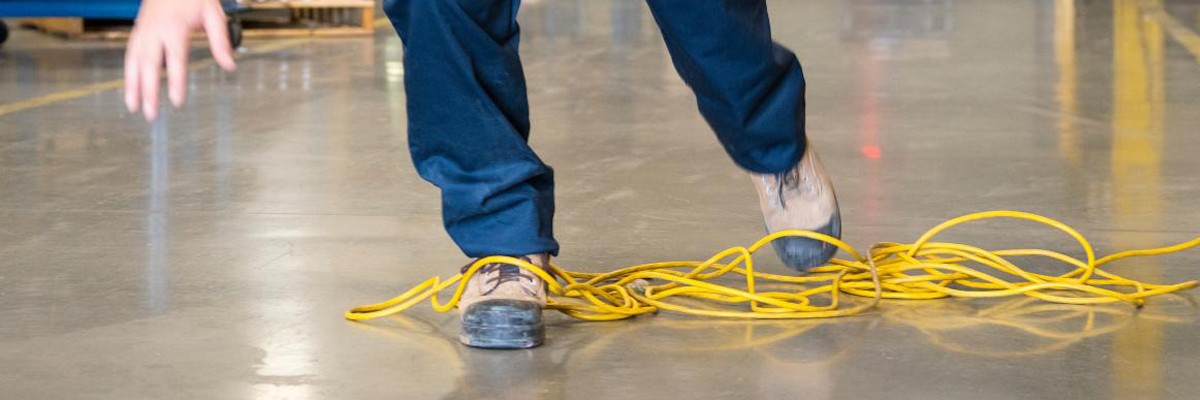Preventing Slips and Trips During Service Calls
Occupational slip and fall injuries cost employers and employees $70 billion annually, according to the National Institute for Occupational Safety and Health. In the pest control industry, workplace slip and fall injuries from stairs, decks, retaining walls, not ladders, made up 30 percent of total work injury claims in ’23 for PestSure insureds.
Slips, trips, and falls in outdoor environments can be caused by uneven surfaces, hidden trip hazards, and weather conditions that create poor traction or that cause pest control technicians to lose their balance. While technicians cannot control environmental conditions that decrease the safety of outdoor walkway surfaces, they can certainly reduce the likelihood of falls through increased awareness and eliminating hazardous situations.
Uneven ground, debris, tools, and wet grass are all potential causes of slips, trips, and falls for pest control personnel. These types of accidents are especially dangerous since technicians often risk falling with a tool in hand or while wearing a backpack.
Although many slip, trip, and fall injuries are minor (for example, sprained ankles and wrists), they can be very costly from a personal perspective because they limit mobility. Some falls result in serious knee and shoulder injuries.
Common Slip and Fall Hazards
What are the come of the most common slip and fall hazards technicians may encounter during a service visit to a residential property or commercial facility. Here is a list of hazards that could cause a slip and fall accident:
- Changing and uneven or slippery surfaces.
- Forgotten tools.
- Debris
- Exiting vehicles or equipment.
- Loading and unloading equipment and materials.
- Navigating decks and steps.
- Walking across unmown or uneven lawn surfaces.
First-Hand Slips and Fall Stories
Many technicians have first-hand experience with slip and fall hazards on the job. Here are some of their stories:
- “While treating a home wearing a backpack sprayer, I tripped and lost my balance on an uneven rock walkway resulting in strained back muscles.”
- “I stepped off the customers deck step and rolled my ankle. I fell to the ground hitting my knee on the sidewalk.”
- “While walking around the corner of the house I tripped over a rake and fell against the corner of the building.”
- “I stepped in a low spot in the yard and strained my knee.”
Slip and Trip Safety Tips
The saying goes that an ounce of prevention is worth a pound of cure, but in the case of on the job slips and falls it is worth a lot more. Reducing the risk of injury benefits both workers and companies in the form of reduced accidents and lower claim costs.
Before technicians start service at an account, they should follow this checklist:
- Survey the area you will cross or work in prior to beginning your service. Make corrections and note hazards before you begin.
- Wear well-fitting non-slip footwear.
- Look down before you get out of your vehicle and use a three-point system for climbing on and off equipment.
- Check worksites for uneven and slippery ground, puddles, and trenches or embankments, uneven spots, and inclines.
- Clean up items and debris left in your work area and planned walkway.
- Plan for safe unloading of equipment and materials.
- Keep truck beds tidy and secure loose items.
While on the job technicians should keep the following safety tips in mind:
- Do not carry more than you can safely handle keeping one hand free.
- Be sure you can see where you are going when carrying large items.
- Slow down and move deliberately over slippery or uneven ground.
- Use extra caution in bad weather.
- Identify and avoid or remove any slip, trip, and fall hazards.
PestSure – Your Partner in Safety
Founded in 1980, PestSure is the only insurance and risk management provider that is 100 percent dedicated to the pest management industry. It offers industry professionals a full suite of insurance, risk management, and safety training and education offerings.
PestSure provides insurance, safety and risk management consulting to pest management companies representing $2 billion in revenue, $750 million in payroll and more than 16,500 service vehicles. The program is administered by Alliant Insurance Services.
Call 888.984.3813 or visit our contact page for more information.
When you subscribe to the blog, we will send you an e-mail when there are new updates on the site so you wouldn't miss them.



Comments